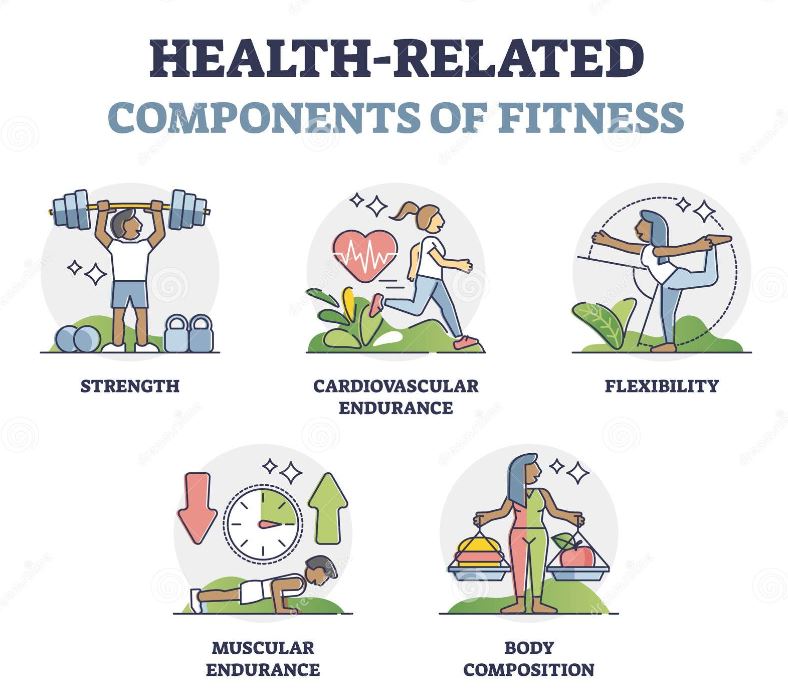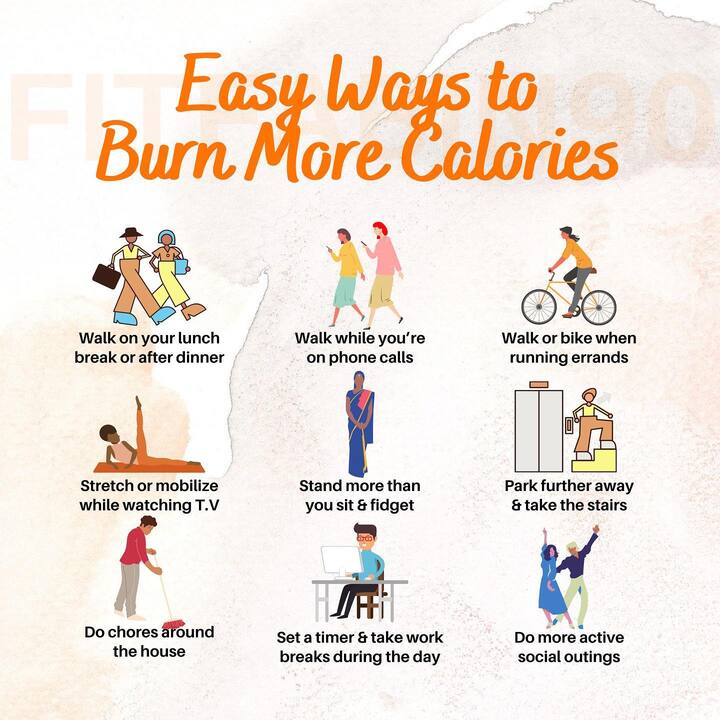Unlocking the Secrets to a Healthier You
When it comes to fitness, the common perception often revolves around sculpting a perfect physique and pushing through intense workouts. However, true fitness is much more than just achieving a certain look. It involves a comprehensive understanding of the five health-related components of physical fitness, which collectively contribute to your overall health and well-being. These components are not just fitness jargon; they are essential aspects of a well-rounded approach to health.
Understanding these components can help you create a balanced fitness routine that not only improves your physical appearance but also enhances your functional health. In this detailed guide, we will explore each component, discuss its importance, and provide actionable tips to improve it. Ready to unlock the secrets to a healthier you? Let’s dive in!
1. Cardiovascular Endurance: Your Heart’s Powerhouse
What Is Cardiovascular Endurance?
Cardiovascular endurance, also known as aerobic fitness, is the capacity of your heart, lungs, and circulatory system to work efficiently during sustained physical activity. This component is crucial because it directly impacts your ability to perform extended activities without feeling exhausted.
Why It Matters:
- Improves Heart Health: Engaging in regular aerobic exercise strengthens the heart muscle, leading to better circulation and lower blood pressure. A strong heart can pump blood more efficiently, reducing the risk of heart disease.
- Boosts Stamina: With improved cardiovascular endurance, you can exercise longer and more effectively. This means you’ll have the energy to tackle daily tasks and engage in recreational activities with ease.
- Enhances Recovery: A well-conditioned cardiovascular system helps you recover faster from intense physical exertion. This allows you to train more frequently and with greater intensity.
How to Improve Cardiovascular Endurance:
- Running or Jogging: Start with short distances and gradually increase as your endurance improves. Running and jogging are classic ways to build cardiovascular strength and stamina.
- Cycling: A low-impact alternative that is easy on the joints while effectively boosting cardiovascular health. Whether you’re cycling outdoors or using a stationary bike, it’s a great way to improve endurance.
- Swimming: Offers a full-body workout and is excellent for enhancing heart and lung capacity. The resistance of water makes swimming a highly effective cardiovascular exercise.
Tips for Success:
- Consistency is Key: Aim for at least 150 minutes of moderate aerobic activity per week or 75 minutes of vigorous activity. Consistency is crucial for building and maintaining cardiovascular endurance.
- Mix It Up: Incorporate various activities into your routine to keep things interesting and to challenge different aspects of your cardiovascular system.
2. Muscular Strength: The Power Within
Understanding Muscular Strength
Muscular strength is defined as the maximum amount of force that a muscle or group of muscles can exert. It is essential for performing various physical tasks, from lifting heavy objects to pushing or pulling.
Why It Matters:
- Supports Daily Activities: Enhanced strength helps with everyday tasks such as lifting groceries, moving furniture, or carrying children. It reduces the risk of injury and makes physical labor easier.
- Boosts Metabolism: Muscle tissue burns more calories than fat, even when at rest. This means that increasing your muscle mass can aid in weight management and overall metabolic health.
- Improves Posture: Strong muscles support better alignment and reduce back pain. Proper muscle support can lead to improved posture and decreased risk of musculoskeletal issues.
How to Build Muscular Strength:
- Weight Training: Use free weights, resistance machines, or bodyweight exercises to challenge your muscles. Focus on major muscle groups with exercises like squats, bench presses, and deadlifts.
- Bodyweight Exercises: Push-ups, squats, and planks are effective for building strength without needing additional equipment. These exercises can be modified to increase difficulty as you progress.
- Resistance Bands: A versatile tool that can be used to perform various strength training exercises. Resistance bands are portable and can be used at home or in the gym.
Tips for Success:
- Progress Gradually: Start with weights or resistance levels that are manageable and increase them slowly to avoid injury and ensure continued progress.
- Focus on Form: Proper technique is essential for maximizing benefits and preventing injuries. Consider working with a trainer to learn the correct form for various exercises.
3. Muscular Endurance: The Ability to Last
What Is Muscular Endurance?
Muscular endurance is the ability of a muscle or group of muscles to sustain repeated contractions over time without becoming fatigued. This component is essential for performing prolonged physical activities and maintaining performance.
Why It Matters:
- Enhances Performance: Good muscular endurance allows you to perform activities such as running, cycling, or rowing for extended periods without early fatigue.
- Reduces Fatigue: Increased endurance helps you avoid early exhaustion during prolonged activities, whether it’s a long workout session or a day of physical labor.
- Improves Functional Fitness: A high level of muscular endurance supports daily activities that require sustained effort, such as carrying groceries or climbing stairs.
How to Improve Muscular Endurance:
- High-Rep Strength Training: Perform exercises with lighter weights and higher repetitions. This approach helps to build endurance in your muscles.
- Circuit Training: Rotate through a series of exercises with minimal rest between them. This method challenges your muscles and cardiovascular system simultaneously, improving overall endurance.
- Endurance Activities: Engage in activities that require sustained effort, such as rowing, cycling, or long-distance running.
Tips for Success:
- Stay Hydrated: Proper hydration is crucial for maintaining endurance during prolonged physical activity. Drink water before, during, and after exercise.
- Listen to Your Body: Avoid overtraining by allowing adequate recovery time between endurance workouts. Pay attention to signs of fatigue and rest as needed.
4. Flexibility: The Key to Movement
Understanding Flexibility
Flexibility refers to the range of motion available at a joint or group of joints. It is an important aspect of physical fitness that contributes to overall mobility and functional movement.
Why It Matters:
- Prevents Injuries: Increased flexibility helps prevent strains, sprains, and other injuries by allowing your muscles and joints to move through their full range of motion.
- Enhances Performance: Better flexibility can improve your performance in various sports and exercises by allowing for more efficient and effective movements.
- Promotes Better Posture: Flexible muscles support proper alignment and reduce back pain, contributing to improved posture and overall comfort.
How to Improve Flexibility:
- Static Stretching: Hold stretches for 15-30 seconds to improve flexibility over time. This type of stretching is best performed after a workout when your muscles are warm.
- Dynamic Stretching: Incorporate movement into your stretches to prepare muscles for activity. Dynamic stretching is effective as a warm-up before exercise.
- Yoga: A comprehensive approach to flexibility that also incorporates balance, strength, and relaxation. Yoga can improve flexibility, reduce stress, and enhance overall well-being.
Tips for Success:
- Stretch Regularly: Incorporate stretching into your daily routine or after each workout to maintain and improve flexibility.
- Warm Up First: Always warm up your muscles before stretching to reduce the risk of injury and improve the effectiveness of your stretching routine.
5. Body Composition: The Balance of Fat and Muscle
What Is Body Composition?
Body composition refers to the proportion of fat and lean mass in your body. A healthy body composition involves a lower percentage of body fat and a higher percentage of lean muscle mass.
Why It Matters:
- Impacts Health: A healthy body composition is associated with a lower risk of chronic diseases such as diabetes, heart disease, and certain cancers. Maintaining a balanced body composition supports overall health and longevity.
- Affects Physical Performance: More muscle and less fat can enhance your performance in various physical activities by improving strength, endurance, and agility.
- Improves Aesthetics: Achieving a balanced body composition can lead to a more toned and fit appearance, which can boost confidence and self-esteem.
How to Improve Body Composition:
- Balanced Diet: Focus on a diet rich in whole foods, lean proteins, healthy fats, and complex carbohydrates. Avoid excessive consumption of processed foods and sugars.
- Strength Training: Build muscle mass through regular resistance exercises, which can help increase your basal metabolic rate and reduce body fat.
- Cardiovascular Exercise: Engage in aerobic activities like running, cycling, or swimming to burn calories and improve overall fitness.
Tips for Success:
- Monitor Progress: Use tools such as body composition scales, measurements, or professional assessments to track changes in your body composition.
- Set Realistic Goals: Aim for gradual, sustainable changes in body composition rather than drastic or quick fixes.
Putting It All Together: A Balanced Approach to Fitness
To achieve overall physical fitness, it’s essential to focus on all five health-related components. Each component contributes uniquely to your well-being and performance. Here’s how you can integrate them into a cohesive fitness plan:
Create a Balanced Routine:
- Incorporate Cardiovascular Activities: Include running, cycling, or swimming to build cardiovascular endurance and support heart health.
- Strength Training: Schedule regular sessions targeting major muscle groups to build strength and enhance metabolism.
- Endurance Workouts: Engage in high-rep strength training or circuit training to improve muscular endurance and overall fitness.
- Flexibility Exercises: Add stretching or yoga to your routine to enhance flexibility and reduce the risk of injury.
- Monitor Body Composition: Track your progress and adjust your diet and exercise regimen to achieve and maintain a healthy body composition.
Set SMART Goals:
- Specific: Define clear, actionable objectives for each fitness component.
- Measurable: Use tools and metrics to track progress and make data-driven adjustments.
- Achievable: Set realistic goals based on your current fitness level and gradually increase the challenge.
- Relevant: Ensure that your goals align with your overall fitness aspirations and lifestyle.
- Time-bound: Establish deadlines for achieving your goals to stay motivated and on track.
Stay Motivated:
- Find Enjoyable Activities: Choose exercises and activities that you enjoy to make your fitness routine more engaging and sustainable.
- Track Your Progress: Celebrate milestones and improvements to stay motivated and committed to your fitness journey.
- Seek Support: Join fitness groups, work with a trainer, or find a workout buddy to provide encouragement and accountability.
Conclusion: Embrace a Holistic Approach to Fitness
Understanding and incorporating the five health-related components of physical fitness—cardiovascular endurance, muscular strength, muscular endurance, flexibility, and body composition—into your routine is essential for achieving overall health and well-being. By focusing on each component, you can improve your physical performance, prevent injuries, and enhance your quality of life.
Remember, achieving fitness is not about quick fixes or extreme measures. It’s about making consistent, balanced efforts across all five components to create a healthier, more vibrant you. So, lace up those sneakers, grab a yoga mat, and start integrating these components into your fitness routine. Your body will thank you with improved health, increased energy, and a more fulfilling life.




